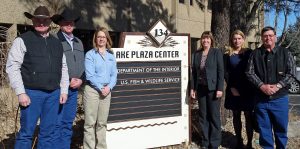
MRCDC and partners continue efforts to improve communication with agencies through face-to-face visits:
Printable Version of News Article
A group of Montana folks representing 4 counties as Conservation District Supervisors and County Commissioners traveled to Denver on January 26th to meet with leaders in the Mountain-Prairie Region of the US Fish and Wildlife Service. Dean Rogge from Garfield County Conservation District, and Steve Wanderaas of McCone County Conservation District, traveled with Missouri River Conservation Districts Council (MRCDC) Coordinator Rachel Frost, Montana Association of Conservation Districts Executive Director Elena Evans, Phillips County Commissioner and local rancher Lesley Robinson, and Fergus County Commissioner Carl Seilstad to the Mile High City. There they met with Noreen Walsh, Regional Director; Matt Hogan, Deputy Regional Director; Will Meeks, Assistant Regional Director of Refuges; and Mike Blenden, Refuge Supervisor for Montana, Wyoming and Utah to discuss locally-led conservation efforts in Montana.
The purpose of the visit was to highlight the success of current locally-led conservation efforts, and to provide local insight on the socially complex issues of bison, endangered species, and changing land use. With both County Commissioners and Conservation District Supervisors in attendance, the group was capable of conveying the broad range of indirect effects that regulatory uncertainty and conservation efforts without local support can provoke in communities.
The attendees described efforts such as the CMR Community Working Group which is a stakeholder group dedicated to enhancing the vitality of the region surrounding the CMR NWR, the Montana Saltcedar Team which is a collaborative approach to prioritizing and treating saltcedar infestations in the Missouri and Musselshell watersheds, and the Montana Rangelands Partnership, which is a public/private partnership to bring technical assistance and uniformity among agencies to rangeland monitoring and whole ranch planning. Efforts such as these and many other examples of locally led conservation practices were described demonstrating the resourcefulness of local communities to work together to solve their natural resource problems.
Along with all the good things that are currently happening in Montana, the group had the opportunity to provide insight on the challenges that conservation efforts are facing. Regional leaders were made aware of the constant pressure on local landowners and how pushing a single species or agenda too strongly can result in lost conservation opportunities across the broader landscape. Landowners expressed their desire to be included in the data collection, interpretation, and decision making efforts of the service and advocated for better communication regarding future petitions of species for protection under the Endangered Species Act.
“For any conservation effort to be successful, it has to have local buy-in and support”, Dean Rogge advocates. Conservation does not always have to be a big endeavor fueled by lots of money; and is often more successful as a local endeavor fueled by the passion of people who care for the land and respect the local economy and culture.
The group concluded by inviting the Regional leadership to Montana, to attend local working groups, and visit personally with local conservation districts and engaged landowners. Walsh expressed her desire to meet with local landowners and thanked the group for making the effort to travel to Denver to reach out and maintain communication. We will try to make that happen with a formal invite this spring.
This trip was also an opportunity for us to show our appreciation for those local agency employees who work with conservation districts and county government to find solutions to natural resource issues that work for everyone. However, sometimes the local agency employees do not receive funding or political support from their supervisors for locally important projects. This can prevent their participation, end the project, and in some cases, damage the relationship between the local agency office and the community. It is our belief that visiting directly with the upper-level management of agencies will encourage them to provide the needed support to local agency offices to work more cooperatively with Conservation Districts and county government. It is good practice to remind the Regional leadership of agencies that decisions they make can have impacts on local communities far outside the confines of their agency. When the federal government makes better decisions by using the input of local people, all of Montana benefits through decision that are more sound, take into account more factors, and focus on sustainability.
